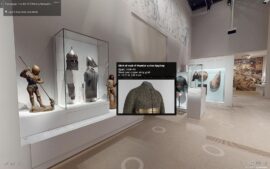Implementing augmented reality (AR) in the art world can bring about transformative changes and enrich the overall experience for creators, audiences, galleries, and museums. Key Performance Indicators (KPIs) play a crucial role in assessing the success and impact of AR initiatives. Here’s a compilation of KPIs for evaluating the implementation of augmented reality in art:
- Engagement Metrics:
- Dwell Time: Measure the amount of time users spend engaging with AR-enhanced art. Increased dwell time indicates a higher level of interest and interaction.
- Interaction Rate: Track the percentage of users who actively interact with AR elements, such as animations, information overlays, or virtual components.
- Audience Reach:
- Downloads/Installs: Monitor the number of downloads or installations of AR applications or experiences. A higher number signifies a broader reach among the target audience.
- Unique Users: Track the number of distinct users engaging with AR content. This metric provides insights into the diversity of the audience.
- Social Media Impact:
- Social Shares: Measure the number of times AR-enhanced art is shared on social media platforms. Increased shares contribute to greater visibility and word-of-mouth promotion.
- Hashtag Mentions: Monitor the usage of specific hashtags related to AR art experiences. This KPI gauges social media conversation and community engagement.
- User Satisfaction:
- Surveys and Feedback: Collect user feedback through surveys to gauge satisfaction levels and identify areas for improvement.
- App Ratings and Reviews: Monitor app store ratings and reviews to assess user sentiment and identify trends in user experiences.
- Artistic Impact:
- Artwork Impressions: Track the number of times AR-enhanced artworks are viewed or experienced. This KPI reflects the impact and popularity of specific art pieces.
- Artistic Collaboration Opportunities: Measure the number of collaborations or partnerships with artists facilitated by the implementation of AR.
- Educational Value:
- Information Retention: Assess the effectiveness of AR in conveying educational content by measuring users’ retention of information provided through AR overlays.
- Incorporation into Curricula: Track the integration of AR-enhanced art experiences into educational programs and curricula.
- Monetization:
- Revenue Generation: If applicable, measure the revenue generated directly from AR art experiences through ticket sales, app purchases, or other monetization channels.
- Partnership ROI: Evaluate the return on investment from partnerships with brands, sponsors, or technology providers in the AR space.
- Technology Adoption:
- Device Compatibility: Assess the compatibility of AR applications with a variety of devices to ensure accessibility for a broad audience.
- Technology Updates: Track the adoption of the latest AR technologies and updates to ensure the art experiences remain current and cutting-edge.
- Accessibility and Inclusivity:
- User Demographics: Analyze user demographics to ensure that AR experiences are reaching diverse audiences.
- Accessibility Features: Implement and measure the effectiveness of accessibility features, ensuring inclusivity for users with disabilities.
- Gallery/Museum Impact:
- Visitor Numbers: Monitor changes in visitor numbers to galleries or museums after the implementation of AR experiences.
- Exhibition Attendance: Measure attendance specifically for AR-enhanced exhibitions or displays.
- Cultural and Community Impact:
- Media Coverage: Track the extent of media coverage and cultural impact resulting from AR art initiatives.
- Community Engagement: Measure the level of engagement and participation from the local community in AR-enhanced art events.
By carefully monitoring these AR in art KPI’s, stakeholders in the art world can gain valuable insights into the success, impact, and areas for improvement in implementing augmented reality experiences.



